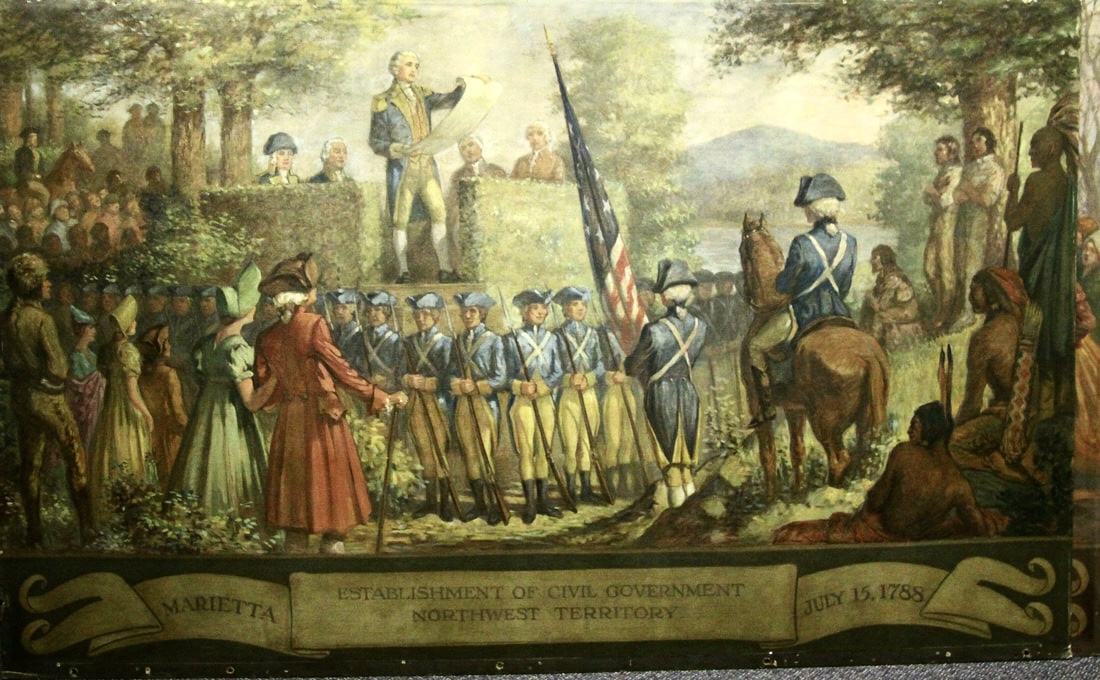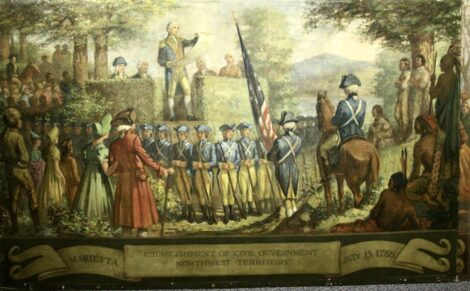The Ordinance of 1787, “They builded better than they knew”
- (Photo provided by decartsohio.org) William Mark Young mural depicting the start of Northwest Territory civil government at Marietta on July 15, 1788.
- Scan to view short video of author David McCullough speaking about the importance of the Ordinance of 1787.

(Photo provided by decartsohio.org) William Mark Young mural depicting the start of Northwest Territory civil government at Marietta on July 15, 1788.
It was a pleasant July day. Our two Old English Sheepdogs Sophie and Tasha ambled down our wooded trail with me. We stepped into total shade at the waterfall under towering maple, oak and sycamore trees. It was quiet. Only the waterfall and a wood thrush were audible.
The trees and the silence reminded me of Marietta’s earliest days in July 1788. The tall trees provided lumber for construction yet hindered growth of crops needed for food. It was quieter then; only the sounds of nature, people, and hand tools were heard. Yet it was a busy time. A year earlier Congress had passed the Ordinance of 1787 which created the first United States territory beyond the original 13 states.
July 9, 1788: Northwest Territory Gov. Arthur St. Clair arrived at Fort Harmar. Hildreth’s Pioneer History: He “was received with military honors and a salute of 14 guns.” Question for the reader: Why the number 14? On July 15, he was installed as governor. The boat that took him across the Muskingum River to Marietta had an oar inscribed with the word “Congress.”
It was probably a tedious ceremony. The entire Ordinance of 1787 was read aloud, as were the commissions listing the duties and responsibilities of each territorial officer: Governor, secretary and three judges. The document for office of Governor: “We (Congress), reposing special trust and confidence in your integrity, prudence and ability, … do constitute and appoint, you, the said Arthur St. Clair, governor, in and over the territory…northwest of the river Ohio; and commander-in-chief of the militia therein; to order, rule, and govern the same, conformably to the (Ordinance of 1787).”
St. Clair addressed the gathering. He praised the character of territorial leaders and encouraged patience and perseverance in the face of challenges. He counseled positive Native American relations: “…treat them on all occasions with kindness, and the strictest regard for justice…” Gen. Rufus Putnam made a brief response to the speech and then “three cheers closed the ceremonies of the day.” It was now “go time” for the new Territory and settlements.

Scan to view short video of author David McCullough speaking about the importance of the Ordinance of 1787.
The Ordinance of 1787 is often relegated to the “dustbin of history” because the Northwest Territory ceased to exist after all of the states were formed.
Historians today, though, classify the Ordinance as one of the three most important in American history, along with the Declaration of Independence and the Constitution. Constitutional lawyer Daniel Webster, said, “…(No) single law…, ancient or modern, has produced effects of more distinct, marked, and lasting character than the Ordinance of 1787.”
The Ordinance contained several firsts in American governance: Human rights guarantees later included in the Bill of Rights, including freedom of religion, trial by jury, property rights, and others; prohibition of slavery, the first such constitutional law anywhere in the world; encouragement of education as necessary for a healthy society, laying the groundwork for America’s first tax-supported schools and universities; and a model for the formation and admission of states to the Union.
Some things you may not know about the Ordinance: Navigation on territorial rivers was to be free and open to all. The first territorial government was appointed, not elected. Gov. St. Clair acknowledged this and stated that acting in the best interests of the residents was “… a very important part of our duty and will be attended to with greatest care.” States formed from the territory would have equal footing with the existing states.
Our pioneering leaders and settlers indeed “builded better than they knew.”
That old-fashioned phrase refers to something that turns out far better and with greater importance than anyone could have imagined.



